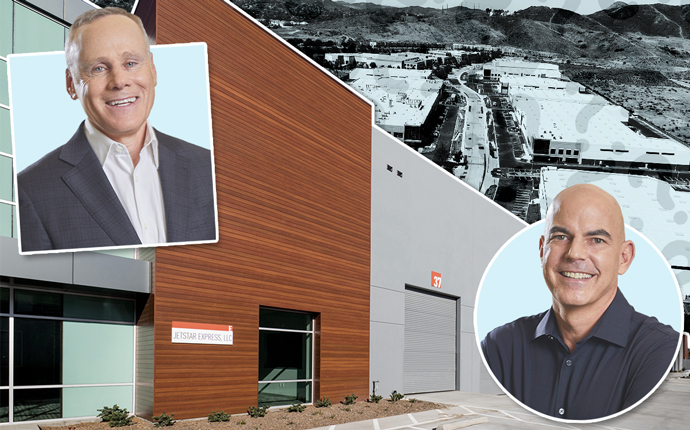Trending
“It’s a large and vast market of opportunity:” Behind Rexford Industrial’s real estate rampage
Co-CEOs of the REIT that owns 22M sf across SoCal have their sights set on market dominance in LA

As one of the largest industrial landlords in Southern California, Rexford Industrial owns more than 22 million square feet of property across the region, about half of which is in Los Angeles County.
At a time when industrial real estate prices are soaring across the country — the Blackstone Group announced Sunday an $18.7 billion acquisition of warehouse assets — Rexford has closed some of the biggest purchases and sales in Southern California over the last several years.
Last year, the real estate investment trust spent $500 million on industrial properties and is keeping up its pace this year. On Monday, the company touted its $34.5 million purchase of two more industrial properties in infill markets near Los Angeles.
The Real Deal caught up with Howard Schwimmer and Michael Frankel, who co-founded Rexford in 2000 and now serve as its co-CEOs, to talk about how they pencil out deals and compete for transactions in one of the country’s hottest industrial markets.
As one of the most active investors in L.A., what’s your short- and long-term strategy?
Michael Frankel: Rexford is solely focused on infill [industrial real estate] in Southern California and [our goal is] to grow the company some multiples of what it is today and stay focused on infill Southern California. It’s a large and vast market of opportunity for us.
Rexford isn’t the only one buying up property — is it a race to hold as much industrial space as possible?
Howard Schwimmer: If we were in a race to buy for the sake of buying, we’d be five or 10 times bigger than we are right now. We make a lot offers on substantially more product than we buy.
Frankel: For us it’s a race to find the right investment opportunities, because our goal is to find deals where we can create value. Industrial is hot and you see a lot of institutional capital targeting industrial, but they’re just kind of moving the “Monopoly” pieces around, whereas we’re looking for opportunity or create more value.
Where do you see the best opportunities to create value?
Schwimmer: Our focus is on markets that don’t have much of any land to talk about, so the opportunity is really in creating value in older assets and occasionally funding an opportunity to build a new structure.
Frankel: In this market, when you think of institutional quality, a lot of people think of brand-new buildings with a lot of glass that look really pretty. But we’re looking at… institutional quality investment. Nowhere in the country can you find better tenant demand fundamentals than you can in infill Southern California, irrespective of the vintage of the building.
How do you navigate a tight market and compete with other investors?
Frankel: We have a dedicated research team and we combine that with a broker marketing and loyalty program, so we consistently bring opportunities to brokers. We bring brokers into deals all the time because they’re best suited to make the seller feel comfortable with the transaction.
Schwimmer: The typical model for most buyers, when we talk about institutional capital, is they’re buying institutional quality industrial real estate. They’re spread thin — they typically have a team that covers many markets in addition to Southern California — so they mostly see fully marketed deals that brokerages put out. When you’re competing [for those deals], it’s really a beauty contest to see who will accept one with the lowest yield. We didn’t want to be in that type of a business. That’s why we focus on off-market deals driven by our own internal research.
Does the REIT model offer advantages in the industrial space?
Frankel: It does. We like the competitive cost of capital. We have permanent capital through the public markets. It enables us to scale in a way to outcompete non-public players. Having a public currency can be an attractive opportunity for a seller who can trade property to Rexford in exchange for ownership in Rexford for a tax-deferred basis. That’s what we call an UpREIT transaction.
You started Rexford almost 20 years ago. Why did you choose the industrial sector?
Frankel: I’ve been doing this for 36 years and I don’t think I knew what I was getting into when I started, but I’m finally in the right place at the right time. There’s tremendous benefit to being focused. It’s difficult to be as focused as we are and create the kind of competitive advantage in what we do if you’re focused across multiple asset classes or even geographies.
Schwimmer: We have owned properties on the creative office side in the past. Those are capital intensive businesses as tenants roll in and out of properties. Our focus is on what we call low-finish industrial. They’re generic buildings that are easily adaptable for tenants to move into, so the frictional cost of moving tenants in and out is extraordinarily low compared to the office side.
What sort of properties and amenities are now in demand?
Frankel: In infill markets, technology is not necessarily a driver for an e-commerce distributor. The most important thing is proximity to the customer. E-commerce is driving a dramatic increase in the movement of warehouse goods and demand for shorter delivery timeframes.
How what kind of impact will an economic downturn have on industrial demand?
Frankel: From early 2009 to late 2010, we saw about a 25-percent reduction in containerized imports through the ports of L.A. and Long Beach. You would think the industrial market must have suffered — [but] it depends on where you own. If you were in the eastern Inland Empire, vacancy doubled, tripled or worse during the Great Recession. In L.A. and Orange counties, vacancy barely moved from 2-4 percent to 3-5 percent, depending on the submarket. These are mission critical locations for most businesses. If they didn’t have to be [here] they would have left a long time ago because it’s the most expensive market to rent in.
Schwimmer: That’s why we have chosen to remain solely focused on infill Southern California.
Who gets to the office first?
Schwimmer: We get here at the exact same time, every day.
Frankel: We still feel like we’re barely out of the starting gate in terms of the company that we have a vision to build. What makes us successful as partners is we’ve always been clear [and communicate our desire] to build a great business. If you stay true to that singular goal, nothing else matters and everything else follows.
This interview has been condensed and edited for clarity.




